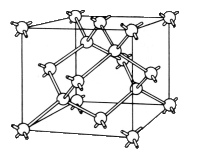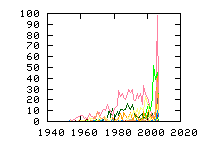« Previous
1
Next »
(3 hits, 1/1)
Showing
10, 25, 50, 100, 500, 1000, all papers per page.
Sort by:
last publication date,
older publication date,
last update date.
- 1. Phys. Rev. B 13, 2511 (1976) , “EPR of a Trapped Vacancy in Boron-Doped Silicon”, G. D. Watkins.An S=1/2 EPR spectrum, labeled Si-G10, is tentatively identified as a lattice vacancy trapped by substitutional boron in silicon. It is produced in boron-doped vacuum floating-zone silicon by 1.5-MeV-electron irradiation at 20.4 K followed by an anneal at ? 180 K, where the isolated vacancy... (Read more)
- 2. Lattice Defects in Semiconductors 23, 1-22 (1975) , Institute of Physics, London , “EPR Studies of the Lattice Vacancy and Low-Temperature Damage Processes in Silocon”, G. D. Watkins.EPR studies of silicon irradiated at 20.4 K and 4.2 K by 1.5 MeV and 46 MeV electrons are described. In 46 MeV irradiations the dominant defects formed appear to be divavancies and other multiple defect aggregates which liberate vacancies throughout the anneal to room temperature as they reorder, recombine, etc. For 1.5 MeV irradiations group III atoms play a vital role in p- and n-type materials in trapping interstitials and stabilizing damage. Carbon and oxygen are not effective interstitial traps at these temperatures. Evidence of limited vacancy migration during irradiation is also cited. Two distinct excited configurations of vacancy-oxygen pairs are identified as precursors to A-centre formation in n-type silicon. The kinetics for their conversion to A-centres depends strongly upon the Fermi level as does the isolated vacancy migration energy whhich is measured to be 0.18 ± 0.02 eV for the V= charge state. The vacancy has four charge states, V+, V0, V- and V=. Kinetics for hole release from V+ reveals an activation barrier of 0.057 eV. The concentration of V+ at 20.4 K in boron-doped material indicates the corresponding donor level even closer to the band edge, approximately EV + 0.039 eV. Jahn-Teller energies for V0, V+, and V- are estimated from stress-alignment studies and confirmed to be large. Kinetics studies for reorientation from one Jahn-Teller distortion to another are also described for each charge state.
- 3. J. Phys. Soc. Jpn. sppl. II, 18, 22 (1963) , “An EPR Study of the Lattice Vacancy in Silicon”, G. D. Watkins.An EPR spectrum is observed in silicon which is identified as arising from the isolated lattice vacancy. It is observed in p-type silicon which has been irradiated in situ at~40ºK by 1.5 Mev electrons. A simple molecular orbital treatment of the vacancy is outlined which describes many of the features of the spectrum and predicts the observed anisotrophy as resulting from a Jahn-Teller distortion. Studies of the disappearance of the vacancy vs anneal are described and interpreted in terms of long range migration of the vacancy and subsequent trapping by other defects. The activation energy for vacancy motion is determined to be 0.33±.03 ev in p-type material. Further study is required in n-type silicon before an unambiguous interpretation of the emergence of vacancy-impurity pairs can be made.
« Previous
1
Next »
(3 hits, 1/1)
Showing
10, 25, 50, 100, 500, 1000, all papers per page.
Sort by:
last publication date,
older publication date,
last update date.
All papers (3399)
Updated at 2010-07-20 16:50:39
Updated at 2010-07-20 16:50:39
(view as: tree
,
cloud
)
| 1329 | untagged |
Materials
(111 tags)
Others(101 tags)
Technique
(46 tags)
Details
(591 tags)
Bond(35 tags)
Defect(interstitial)(18 tags)
Defect(vacancy)(15 tags)
Defect-type(19 tags)
Element(65 tags)
Energy(8 tags)
Isotope(56 tags)
Label(303 tags)
Sample(17 tags)
Spin(8 tags)
Symmetry(15 tags)

